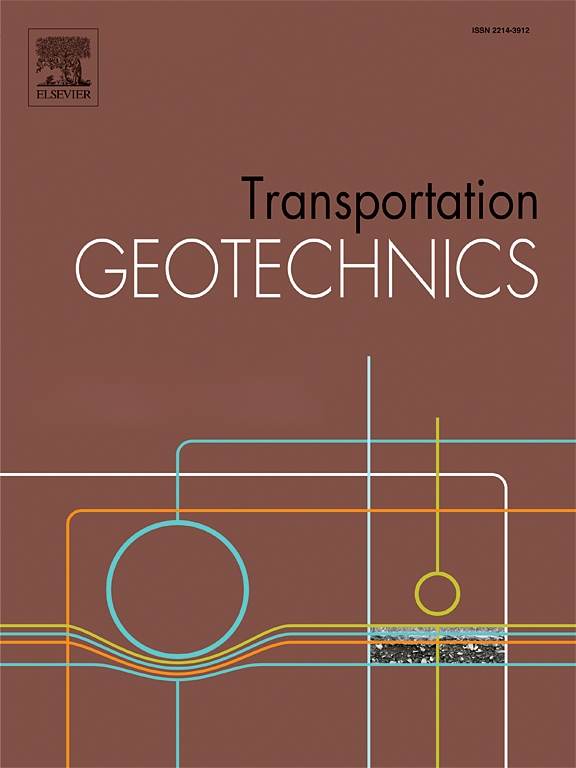Limit support pressure of shield excavation face under-crossing the existing metro station
IF 5.5
2区 工程技术
Q1 ENGINEERING, CIVIL
引用次数: 0
Abstract
With the progression of urban development, the occurrence of shield tunnels intersecting existing transportation hubs has become increasingly prevalent. When a tunnel is constructed beneath an existing station, the stress distribution within the surrounding soil is altered, leading to variations in the support pressure at the excavation face of the shield tunnel. However, the current literature lacks a calculation method for determining the support pressure at the excavation face in such scenarios. This research utilizes three-dimensional finite element numerical simulations to examine the soil responses associated with a shield tunnel that under-crossing an existing metro station situated within a typical clay-gravel stratum. The study specifically addresses the failure of the excavation face at varying distances from the existing station. The analysis encompasses the support pressure at the excavation face, soil displacement and stress, as well as the three-dimensional failure model. Based on the findings from the numerical simulations, a modified formula for calculating overburden earth pressure is proposed, which incorporates the influence of the overlying station. Following this modification, the relative error in the calculation of overburden earth pressure is reduced from 67.4% to 3.9%. Furthermore, when the modified formula is applied to assess the overburden earth pressure within a three-dimensional wedge-prism model of the clay-gravel strata, the relative error in the calculation of limit support pressure is decreased from 8.7% to 0.5%. The proposed modified formula for overburden earth pressure serves as a significant reference for determining the limit support pressure of the excavation face when a tunnel under-crossing the existing station.
既有地铁车站下穿盾构开挖工作面极限支护压力
随着城市的发展,盾构隧道与既有交通枢纽交叉的现象越来越普遍。当隧道在既有车站下施工时,会改变周围土体的应力分布,导致盾构隧道开挖面支护压力发生变化。然而,目前的文献缺乏确定这种情况下开挖工作面支护压力的计算方法。本研究利用三维有限元数值模拟来研究盾构隧道下穿位于典型粘土-砾石地层中的现有地铁站的土壤响应。该研究特别解决了与现有站点不同距离的开挖面破坏问题。分析包括开挖工作面支护压力、土体位移和应力以及三维破坏模型。根据数值模拟结果,提出了考虑上覆站影响的覆盖层土压力计算修正公式。修正后,覆盖层土压力计算的相对误差由67.4%减小到3.9%。将修正公式应用于粘土-砾石地层三维楔棱镜模型中覆岩土压力计算时,计算极限支护压力的相对误差由8.7%减小到0.5%。修正后的覆盖层土压力计算公式对隧道下穿既有车站时开挖工作面极限支护压力的确定具有重要的参考意义。
本文章由计算机程序翻译,如有差异,请以英文原文为准。
求助全文
约1分钟内获得全文
求助全文
来源期刊

Transportation Geotechnics
Social Sciences-Transportation
CiteScore
8.10
自引率
11.30%
发文量
194
审稿时长
51 days
期刊介绍:
Transportation Geotechnics is a journal dedicated to publishing high-quality, theoretical, and applied papers that cover all facets of geotechnics for transportation infrastructure such as roads, highways, railways, underground railways, airfields, and waterways. The journal places a special emphasis on case studies that present original work relevant to the sustainable construction of transportation infrastructure. The scope of topics it addresses includes the geotechnical properties of geomaterials for sustainable and rational design and construction, the behavior of compacted and stabilized geomaterials, the use of geosynthetics and reinforcement in constructed layers and interlayers, ground improvement and slope stability for transportation infrastructures, compaction technology and management, maintenance technology, the impact of climate, embankments for highways and high-speed trains, transition zones, dredging, underwater geotechnics for infrastructure purposes, and the modeling of multi-layered structures and supporting ground under dynamic and repeated loads.
 求助内容:
求助内容: 应助结果提醒方式:
应助结果提醒方式:


